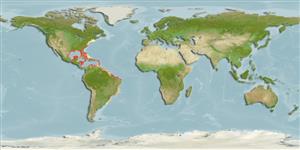Common names from other countries
Issue
Matsuura (2003: Ref. 53032) places this species in the genus Rhinesomus.
Environment: milieu / climate zone / depth range / distribution range
Écologie
marin récifal; profondeur ? - 50 m (Ref. 12204). Subtropical; 44°N - 35°S, 98°W - 34°W
Western Atlantic: Canada (Ref. 12204) and Massachusetts, USA to Brazil, including Bermuda, the Gulf of Mexico and the Caribbean.
Taille / Poids / Âge
Maturity: Lm ? range ? - ? cm
Max length : 47.0 cm TL mâle / non sexé; (Ref. 7251); common length : 20.0 cm TL mâle / non sexé; (Ref. 3696)
Carapace and caudal peduncle blackish with numerous small white spots; lips and bases of fins blackish; terminal edge of caudal fin narrowly white with a blackish submarginal band (Ref. 13442).
Found on coral reefs (Ref. 12204). Solitary or in small groups (Ref. 9710). Feeds on a wide variety of small bottom invertebrates such as mollusks, crustaceans, worms, sessile tunicates and sponges exposed by a jet of water ejected through the mouth (Ref. 9710). Marketed fresh locally (Ref. 3696). Toxins released when excited kill other fishes (Ref. 5521). Easily approached (Ref. 9710).
Life cycle and mating behavior
Maturities | Reproduction | Spawnings | Egg(s) | Fecundities | Larves
Coad, B.W., 1995. Encyclopedia of Canadian fishes. Canadian Museum of Nature and Canadian Sportfishing Productions Inc. Singapore. (Ref. 12204)
Statut dans la liste rouge de l'IUCN (Ref. 130435)
CITES (Ref. 128078)
Not Evaluated
Menace pour l'homme
Reports of ciguatera poisoning (Ref. 30911)
Utilisations par l'homme
Pêcheries: intérêt commercial mineur; Aquarium: Commercial
Outils
Articles particuliers
Télécharger en XML
Sources Internet
Estimates based on models
Preferred temperature (Ref.
115969): 22.7 - 28, mean 25.7 (based on 396 cells).
Phylogenetic diversity index (Ref.
82804): PD
50 = 0.6250 [Uniqueness, from 0.5 = low to 2.0 = high].
Bayesian length-weight: a=0.05012 (0.02762 - 0.09093), b=2.77 (2.60 - 2.94), in cm Total Length, based on LWR estimates for this species & (Sub)family-body (Ref.
93245).
Niveau trophique (Ref.
69278): 3.3 ±0.2 se; based on diet studies.
Résilience (Ref.
120179): Haut, temps minimum de doublement de population inférieur à 15 mois (Fec assumed to be > 10,000).
Fishing Vulnerability (Ref.
59153): Moderate vulnerability (37 of 100).
